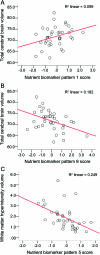Nutrient biomarker patterns, cognitive function, and MRI measures of brain aging
- PMID: 22205763
- PMCID: PMC3280054
- DOI: 10.1212/WNL.0b013e3182436598
Nutrient biomarker patterns, cognitive function, and MRI measures of brain aging
Abstract
Objective: To examine the cross-sectional relationship between nutrient status and psychometric and imaging indices of brain health in dementia-free elders.
Methods: Thirty plasma biomarkers of diet were assayed in the Oregon Brain Aging Study cohort (n = 104). Principal component analysis constructed nutrient biomarker patterns (NBPs) and regression models assessed the relationship of these with cognitive and MRI outcomes.
Results: Mean age was 87 ± 10 years and 62% of subjects were female. Two NBPs associated with more favorable cognitive and MRI measures: one high in plasma vitamins B (B1, B2, B6, folate, and B12), C, D, and E, and another high in plasma marine ω-3 fatty acids. A third pattern characterized by high trans fat was associated with less favorable cognitive function and less total cerebral brain volume. Depression attenuated the relationship between the marine ω-3 pattern and white matter hyperintensity volume.
Conclusion: Distinct nutrient biomarker patterns detected in plasma are interpretable and account for a significant degree of variance in both cognitive function and brain volume. Objective and multivariate approaches to the study of nutrition in brain health warrant further study. These findings should be confirmed in a separate population.
Figures

Comment in
-
The good, bad, and ugly? How blood nutrient concentrations may reflect cognitive performance.Neurology. 2012 Jan 24;78(4):230-1. doi: 10.1212/WNL.0b013e31824367da. Epub 2011 Dec 28. Neurology. 2012. PMID: 22205762 No abstract available.
-
Nutrient biomarker patterns, cognitive function, and MRI measures of brain aging.Neurology. 2012 Apr 17;78(16):1281; author reply 1281-2. doi: 10.1212/01.wnl.0000414241.41860.13. Neurology. 2012. PMID: 22508852 No abstract available.
Similar articles
-
Nutrient biomarker patterns, cognitive function, and fMRI measures of network efficiency in the aging brain.Neuroimage. 2019 Mar;188:239-251. doi: 10.1016/j.neuroimage.2018.12.007. Epub 2018 Dec 7. Neuroimage. 2019. PMID: 30529508
-
Specific nutrient patterns are associated with higher structural brain integrity in dementia-free older adults.Neuroimage. 2019 Oct 1;199:281-288. doi: 10.1016/j.neuroimage.2019.05.066. Epub 2019 May 30. Neuroimage. 2019. PMID: 31154046
-
An Inflammation-related Nutrient Pattern is Associated with Both Brain and Cognitive Measures in a Multiethnic Elderly Population.Curr Alzheimer Res. 2018 Mar 14;15(5):493-501. doi: 10.2174/1567205015666180101145619. Curr Alzheimer Res. 2018. PMID: 29298649 Free PMC article.
-
Diet, nutrition and the ageing brain: current evidence and new directions.Proc Nutr Soc. 2018 May;77(2):152-163. doi: 10.1017/S0029665117004177. Epub 2018 Jan 10. Proc Nutr Soc. 2018. PMID: 29316987 Review.
-
Effects of nutrients (in food) on the structure and function of the nervous system: update on dietary requirements for brain. Part 1: micronutrients.J Nutr Health Aging. 2006 Sep-Oct;10(5):377-85. J Nutr Health Aging. 2006. PMID: 17066209 Review.
Cited by
-
Diet and Neuroimaging Markers of Cerebrovascular Disease.Curr Nutr Rep. 2013 Jun 1;2(2):81-89. doi: 10.1007/s13668-013-0044-4. Curr Nutr Rep. 2013. PMID: 24066275 Free PMC article.
-
Parahippocampal Cortex Mediates the Relationship between Lutein and Crystallized Intelligence in Healthy, Older Adults.Front Aging Neurosci. 2016 Dec 6;8:297. doi: 10.3389/fnagi.2016.00297. eCollection 2016. Front Aging Neurosci. 2016. PMID: 27999541 Free PMC article.
-
The influence of n-3 polyunsaturated fatty acids on cognitive function in individuals without dementia: a systematic review and dose-response meta-analysis.BMC Med. 2024 Mar 12;22(1):109. doi: 10.1186/s12916-024-03296-0. BMC Med. 2024. PMID: 38468309 Free PMC article.
-
Mediterranean diet and dementia: MRI marker evidence from meta-analysis.Eur J Med Res. 2025 Jan 16;30(1):32. doi: 10.1186/s40001-025-02276-1. Eur J Med Res. 2025. PMID: 39815306 Free PMC article.
-
Diet and disease-related outcomes in multiple sclerosis: A systematic review of clinical trials.Curr J Neurol. 2022 Jan 5;21(1):52-63. doi: 10.18502/cjn.v21i1.9362. Curr J Neurol. 2022. PMID: 38011464 Free PMC article. Review.
References
-
- Morris MC, Evans DA, Bienias JL, et al. Dietary intake of antioxidant nutrients and the risk of incident Alzheimer disease in a biracial community study. JAMA 2002;287:3230–3237 - PubMed
-
- Rinaldi P, Polidori MC, Metastasio A, et al. Plasma antioxidants are similarly depleted in mild cognitive impairment and in Alzheimer's disease. Neurobiol Aging 2003;24:915–919 - PubMed
-
- Seshadri S, Beiser A, Selhub J, et al. Plasma homocysteine as a risk factor for dementia and Alzheimer's disease. N Engl J Med 2002;346:476–483 - PubMed
-
- Morris MC, Evans DA, Tangney CC, Bienias JL, Wilson RS. Fish consumption and cognitive decline with age in a large community study. Arch Neurol 2005;62:1849–1853 - PubMed
Publication types
MeSH terms
Substances
Grants and funding
LinkOut - more resources
Full Text Sources
Other Literature Sources
Medical
